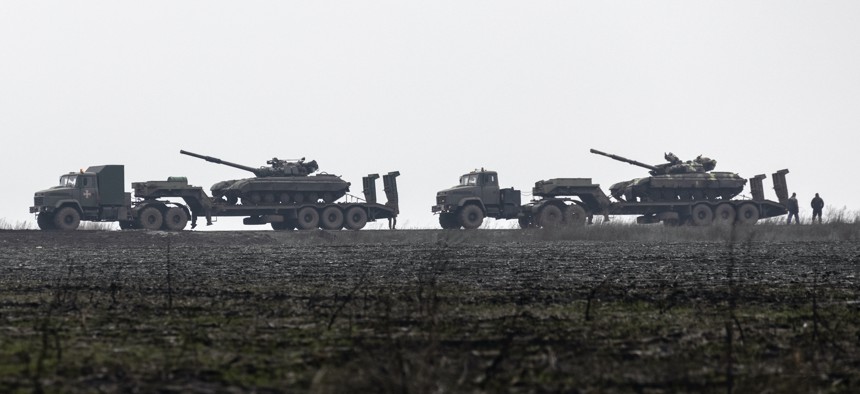
Ukrainian tanks are transported towards to the Luhansk region, Ukraine, Dec. 12, 2021. AP / Andriy Dubchak
It is now quite conceivable that a major war will take place in Europe. Moreover, it is also possible that this war could spread quickly to Asia too, but we will put that grave issue aside momentarily. What are President Vladimir Putin’s war aims? How did it come to the brink of war? Is there anything that can stop this descent into darkness?
In a leaked memo published by the Washington Post on Dec. 3, U.S. intelligence agencies said Russian forces are now poised for a multi-pronged attack with “100 battalion tactical groups,” comprising about 175,000 soldiers that are either deployed or now deploying. This is apparently double the size of the Russian forces that came to the border with Ukraine during the war scare of spring 2021. The report also notes ominously that Moscow has been calling up reserve forces. Some have said that the Kremlin’s legions are simply waiting for the mud to harden into ice, so that the Russian tanks can maneuver more swiftly. With a cold front now moving into the region, Russian military leaders may be looking for a victory that can be celebrated over the New Year holiday.
The Russian military has been equipping and training for such a blitz for the last two decades, and it may seem in retrospect that seizing Crimea in spring 2014 was merely the appetizer before the main course. It could certainly turn out that the Russian President seeks only to close the wound of Donbass, excising these small eastern regions of Luhansk and Donetsk to end that bleeding conflict once and for all. Russian nationalists have called incessantly for such a move since 2014.
Yet a larger and more ambitious operation cannot be ruled out. Viewing a “crisis as an opportunity,” in a similar way to 2014, Putin may opt for a full split of Ukraine into two halves. A simple glance at a cultural-linguistic map yields that all the southern and eastern provinces of Ukraine are majority Russian-speaking. For Russians, the very name “Poltava” (one of Ukraine’s eastern provinces) evokes a clarion call to war almost as meaningful as the name “Sevastopol” in Crimea. Indeed, it was Peter the Great, Putin’s idol and inspiration, who decisively defeated the invading Swedish army at Poltava in 1709, paving the way for the creation of the modern Russian state.
Even more ambitious, Russia may lunge for Odessa, the remarkable city on the Black Sea founded by the Russian empress Catherine the Great in 1794. The site of an anti-Russian atrocity in May 2014, Odessa would not only provide Russia’s proud Black Sea Fleet a new home, but would also end the frequent and affronting visits by NATO warships. (The seizure would come with a side of irony, a special attribute of Russian humor, in that American taxpayers have footed the bill for a recent upgrade of Odessa’s naval piers.) If Putin chooses to kill two birds with one stone, he may authorize his armies to venture even as far as Moldova, since that post-Soviet country already has an enclave in Transnistria, where Russian tanks are guaranteed to be greeted with garlands of flowers.
It is perhaps beyond diplomacy to avoid tragedy at this late point. Over and over, Washington has chosen confrontation over compromise with Moscow over the last two decades. During the 1990s, the Clinton administration pushed through NATO expansion, despite the warning of America’s most experienced diplomat George Kennan, who predicted that the move would plant the seed for a new Cold War. As usual, Kennan was right. The Bush administration aggravated the situation by letting in a whole new raft of countries and tearing up a string of arms control treaties. While Obama tried bravely to reset the relationship, his incompetent diplomats failed miserably to bring peace and stability to eastern Europe. Trump, under constant attack as a “Putin stooge,” upped the ante by granting lethal aid to Ukraine’s military, recklessly expanded the pace of U.S. military exercises on Russia’s borders, and scrapped nearly all that remained of arms control with Moscow.
What peace offering could Washington now offer? To state the obvious, it could quickly and publicly agree to close the NATO door to both Georgia and Ukraine. That might stave off the looming conflict and save Ukraine, but a lasting peace for the region would have to go several steps further: by re-entering crucial arms control agreements like the Open Skies and Intermediate-Range Nuclear Forces treaties, and even more foundational pacts like the Anti-Ballistic Missile and Conventional Armed Forces in Europe treaties.
Yet to truly transform European security away from the new Cold War, NATO countries need to bury the hatchet, halt the unceasing buildup in Eastern Europe, and—bitter a pill as it may be—recognize Russian sovereignty in Crimea, the real source of the region’s ongoing tensions. As an intermediary step toward these goals, it might be advisable for NATO Secretary General Jan Stoltenberg and various senior Biden advisors to take some basic night courses on international relations that teach about “red lines” as well as “spheres of influence.” Such concepts, which have caused many wars, cannot be wished away with fine-sounding liberal rhetoric.
Returning to Asia, it seems possible that Beijing will find the opportunity of a Russian invasion of Ukraine too good to pass up and could opt to solve the Taiwan “problem” at the same time, while Washington is distracted. Please fasten your seatbelts for some significant turbulence.
Lyle J. Goldstein is Director of Asia Engagement at Defense Priorities.



